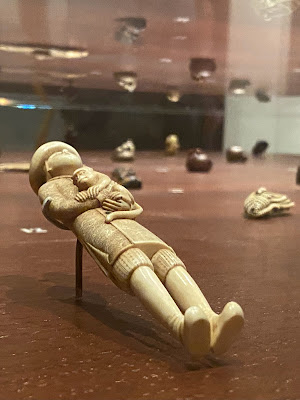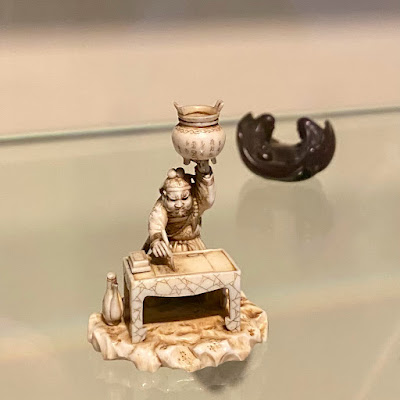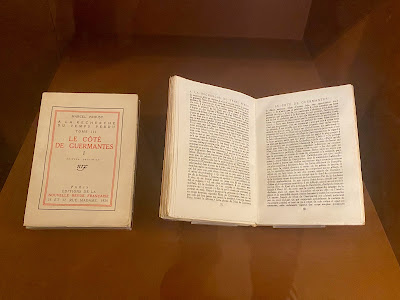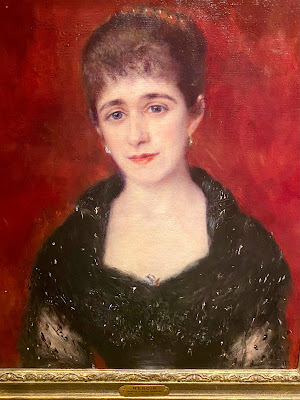Cynthia, a college friend, introduced me to netsuke. She collected them long before ivory hunters decimated elephant populations around the world. So when the Times reviewed an exhibition of 157 of these tiny carvings, initially created to secure small boxes to pocketless kimonos during the 18th and 19th centuries, at the Jewish Museum, I couldn't wait to go.
 |
| Foreigner with a Monkey (1890) |
 |
| Dog & Her Pups (1870) |
 |
| Buddhist Monk Encircled by a Dragon (1780) |
 |
| Figure Holding Up a Cauldron (ca. 1880) |
Some are carved from wood and a variety of other materials.
 |
| Ja Mask (1880) |
This seductive critter gave the exhibit its name: The Hare With Amber Eyes: A Hidden Inheritance, also the title of a memoir by Edmund de Waal, a British ceramicist, who inherited the netsuke collection in 1997 from his great uncle Iggie.
Their post-creation story begins with this man, Charles Iphrussi, a bachelor dilettante (hmmmmm) who Marcel Proust partially re-imagined as Charles Swann in Remembrance of Things Past. The Iphrussis, a Jewish banking family from Ukraine as wealthy as the Rothschilds, got their start as grain importers (shades of The Lehman Trilogy!).
Charles, who collected and wrote about art, supposedly bought more than 250 netsuke to impress a mistress but eventually gave them as a wedding gift to his uncle Ignace, whose taste in art wasn't quite so progressive. Other Iphrussi acquisitions on exhibit include this parochet, or curtain of the torah shrine, that was once part of a wedding dress!
Renoir, who swallowed his anti-Semitism for paid commissions, painted one of the Iphrussi women. .
Iphrussi homes in both Vienna and Paris eventually became prime targets of Nazi looting. Ceilings in their palatial Paris home, the Hotel Iphrussi, were painted with these designs. The exhibit includes photos of what the hotel's rooms look like today.
Charles's aunt kept the netsuke collection in her bedroom but allowed the family's children to play with them. Their size meant a sympathetic maid could stuff them first into her apron pockets and then a mattress before the Nazis could seize them. The entire collection fit into a medium-size valise, also on display.
Another Ignace (known as Iggie), Charles's nephew in Paris, eventually inherited the collection after its safe return to the Iphrussis. Iggie emigrated to America in 1938, continuing his career as a dress designer in both New York and Los Angeles before enlisting in the US Army. He served at the Normandy landings which began the liberation of France and helped turn the tide of World War II.
Iggie bequeathed the netsuke collection to his great nephew, Edmund de Waal, a major proponent of open borders in Europe.
In fact, de Waal auctioned 79 netsuke and gave the proceeds to the Refugee Council, a British organization. The Jewish Museum displays them two-dimensionally.












No comments:
Post a Comment